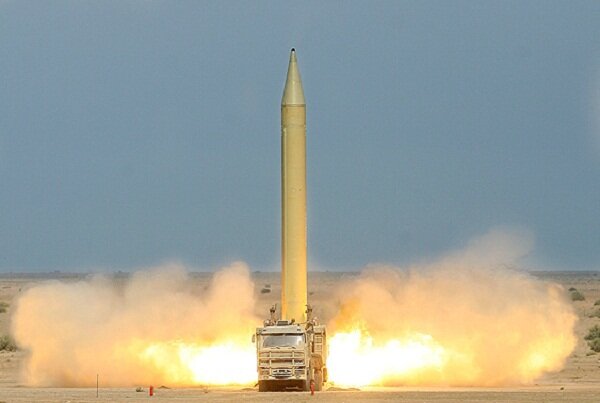IRGC ground force armed with missiles and other new arms

TEHRAN— In a ceremony on July 7, the Islamic Revolution Guards Corp were delivered dozens of new military equipment including missiles.
The IRGC has provided a detailed report of the delivered equipment.
During the ceremony, one of the latest achievements in Iran’s missile industry, called Fath, was provided to the IRGC ground forces with several types of launchers.
For the first time, a missile with a very high resemblance to Fateh-110 but with smaller dimensions were observed in the military exercises of the Great Prophet 14 in the summer of last year. It was observed that while confirming the maximum similarity, its smaller dimensions were recognizable compared to the successful family of Fateh-110 and the Zelzal rocket which was the basis of the propulsion design and body of Fateh-110.
Although no official information has been released about the Fath missile, it has been handed over to at IRGC naval and ground forces.
In March 2017, the missile was mounted inside a cylindrical launcher or canister that was mounted on a truck twice, and a large number of these canisters were delivered to this force in the naval missile cities of the IRGC, which is a great change in combat.
But in the delivery to the IRGC ground forces, three types of launchers were observed for the Fath missile; the launcher with 6 canisters and a double rail launcher as well as four camouflaged trucks. By using four- and six-launcher launchers, it is possible for the ground forces to achieve massive but very accurate fire volumes, making this force somewhat independent of the need for IRGC air force missile systems in tactical missions. In missions that require heavy warfare or longer range, cooperation between the air forces and ground forces will continue to pave the way for future missions.
Another important aspect of delivered new equipment and weapons was the observation of several new anti-tank missiles. In addition to delivering several Dehlawieh missile launchers and samples based on the Safir tactical vehicle, a new type of Dehlawieh missile was also delivered to the ground forces. As previously seen in recent years at the Ministry of Defense exhibitions, it is being evaluated based on a comparison with similar Russian models with a range of 8 km instead of the previous 5.5 km, but official sources have not yet released information about the missile.
The missile has a larger diameter in the middle of its body than the Dehlawieh base model, which can be a larger space for propulsion. Also, the end blocks of the body are made in a semi-oval shape instead of the trapezoidal shape in the previous model, which creates less induction delay at subsonic speed.
Another weapon handed over to the ground forces was the ground model of the new diamond rocket. For the first time, a picture of a new missile similar to the Israeli Spike was seen during the visit of the members of the national security committee of the parliament to the Defense Achievements Exhibition in January 2016. Then, a picture of a new anti-tank missile launcher in the evolution of Iranian anti-tank missiles was seen in the exhibition of the 40-year Achievements of the Islamic Revolution in Tehran, in February 2016.
This launcher, which was very similar to the model used in the Spike missile made by the Zionist regime, brought closer the speculation that the Iranian experts have somehow acquired this missile and have produced a new product based on it.
The mentioned missile was also seen launching from the Ababil-3 light UAV in the videos released on the sidelines of the mass delivery of UAVs to the Army in April 2016 and was introduced as the Almas missile in a joint UAV exercise in December 2016.
This weapon is an air-launched missile with a solid-fuel rocket engine and wings that open from inside the fuselage and uses a thermal image finder as its guidance system.
The range of the missile after being launched from drones is 8 km.
Among the aircraft used by the IRGC ground force, in addition to the Mi-171 helicopters, which are equipped with heavy weapons such as the 240 mm S24 rocket, improved gyroplanes were also present at the ceremony.
These lightweight gyroplanes have been developed for use by ranger teams and can land and take off almost vertically. One of the birds had an electro-optical detection platform and the other had a bed to carry the wounded. The ground transport truck of this flying vehicle, which can transport it quickly, was also seen in the pictures.
Last year, images of the use of a new, advanced design drone called Meraj 1 were published by the IRGC ground force. Despite its light weight, the drone has a high flight continuity and its design is very similar to an advanced American drone.
Meraj 1 with a take-off mass of 33 kg can reach a flight duration of ten and a half hours and can carry up to 5 kg of cargo. The drone reaches a speed of 140 kilometers per hour and a flight ceiling of 3,650 meters (about 12,000 feet). The vertical flight model of Ascension 1 was also delivered to the IRGC Navy last year.
It is hoped that the process of equipping the armed forces in the Army and the IRGC with new weapons, equipment, and more advanced vehicles, especially in the field of personal protection and individual weapons would be developed further.
SA/PA
